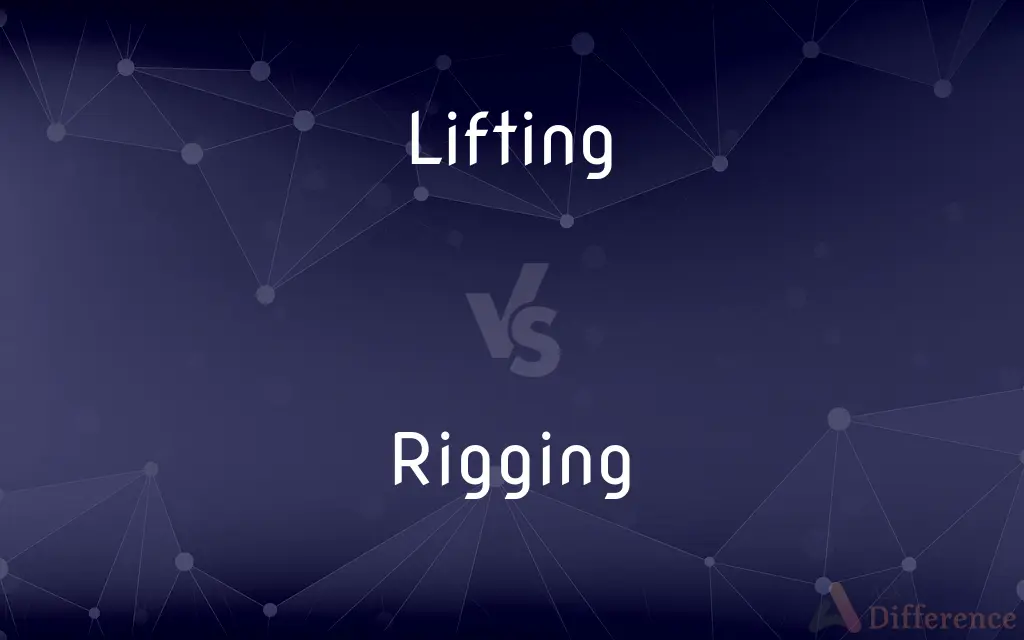Lifting vs. Rigging — What's the Difference?
By Fiza Rafique & Maham Liaqat — Updated on April 1, 2024
Lifting involves raising or moving objects vertically with equipment like cranes and hoists, while rigging encompasses preparing and securing these objects for lifting, using slings, chains, and other accessories.

Difference Between Lifting and Rigging
Table of Contents
ADVERTISEMENT
Key Differences
Lifting is a direct action where objects are moved vertically or to different elevations, utilizing mechanical means such as cranes, hoists, and winches. This process focuses on the actual movement, emphasizing the safe and efficient transfer of objects from one level to another. On the other hand, rigging is the preparatory phase where objects are made ready for lifting. This involves selecting, attaching, and securing the right lifting accessories—like slings, chains, shackles, and wire ropes—to ensure that the load is balanced and secure during the lift.
In lifting, the primary considerations are the capacity of the lifting device, the weight and dimensions of the load, and the lift path to ensure safety and effectiveness. Whereas, in rigging, the focus shifts to the correct attachment and arrangement of rigging equipment to maintain the load's stability and integrity, and to prevent accidents or damage during the lifting process.
Lifting operations often require skilled operators who can maneuver lifting equipment safely, while rigging tasks necessitate riggers with a deep understanding of load dynamics, rigging hardware, and safety standards to appropriately secure loads for lifting.
The equipment used in lifting, such as cranes and hoists, is designed specifically for the vertical movement of loads. Conversely, rigging equipment includes a variety of accessories that can be adapted and combined in numerous ways to suit different loads and lifting requirements, highlighting the versatility required in rigging setups.
Both lifting and rigging are critical components of material handling and construction projects, requiring detailed planning, safety considerations, and skilled personnel. While lifting focuses on the execution of moving loads, rigging ensures that this movement can be carried out safely and efficiently by properly securing and balancing the loads before they are lifted.
ADVERTISEMENT
Comparison Chart
Purpose
To move objects vertically or to different elevations
To prepare and secure objects for lifting
Key Focus
Safe and efficient transfer of loads
Correct attachment and balancing of loads
Equipment Used
Cranes, hoists, winches
Slings, chains, shackles, wire ropes
Required Skillset
Operation of lifting devices
Knowledge of load dynamics and rigging hardware
Safety Considerations
Weight and dimensions of the load, lift path
Stability and integrity of the load during lift
Compare with Definitions
Lifting
It requires understanding the load capacity of equipment.
Choosing a hoist that can safely lift a specific weight.
Rigging
Rigging is the process of attaching loads to lifting devices.
Using slings to connect a cargo to a crane hook.
Lifting
Lifting involves using equipment to raise objects.
A crane lifting materials to the top of a construction site.
Rigging
The integrity of rigging equipment is crucial for safety.
Inspecting shackles and hooks for wear and damage before use.
Lifting
Lifting operations can vary in scale.
From a simple pulley system to lift a small load to a large crane lifting heavy equipment.
Rigging
Rigging strategies can be complex.
Devising a multi-point lift for an irregularly shaped object.
Lifting
Lifting equipment is designed for vertical movement.
An elevator used to lift goods within a building.
Rigging
It involves selecting the right rigging gear for the load.
Choosing chains over wire ropes for abrasive materials.
Lifting
Safety in lifting includes securing the load and clear communication.
Using signals during a crane operation.
Rigging
Rigging requires balancing the load for even lifting.
Positioning slings to keep the load level.
Lifting
To direct or carry from a lower to a higher position; raise
Lift one's eyes.
Lifted the suitcase.
Rigging
Rigging comprises the system of ropes, cables and chains, which support a sailing ship or sail boat's masts—standing rigging, including shrouds and stays—and which adjust the position of the vessel's sails and spars to which they are attached—the running rigging, including halyards, braces, sheets and vangs.
Lifting
To transport by air
The helicopter lifted the entire team to the meet.
Rigging
(Nautical) The system of ropes, chains, and tackle used to support and control the masts, sails, and yards of a sailing vessel.
Lifting
To revoke by taking back; rescind
Lifted the embargo.
Rigging
The supporting material for construction work.
Lifting
To bring an end to (a blockade or siege) by removing forces.
Rigging
Dress; tackle; especially (nautical), the ropes, chains, etc., that support the masts and spars of a sailing vessel, and serve as purchases for adjusting the sails, etc.
Lifting
To cease (artillery fire) in an area.
Rigging
Similar supporting material used for construction work, or in film, theater, etc.
Lifting
To raise in condition, rank, or esteem
Work that lifted her in the eyes of her colleagues.
Rigging
Present participle of rig
Lifting
To uplift; elate
Your telephone call really lifted my spirits.
Rigging
Dress; tackle; especially (Naut.), the ropes, chains, etc., that support the masts and spars of a vessel, and serve as purchases for adjusting the sails, etc. See Illustr. of Ship and Sails.
Lifting
To remove (plants) from the ground for transplanting.
Rigging
Gear consisting of ropes etc. supporting a ship's masts and sails
Lifting
To project or sound in loud, clear tones
Lifted their voices in song.
Rigging
Formation of masts, spars, sails, etc., on a vessel
Lifting
(Informal) To steal; pilfer
A thief lifted my wallet.
Lifting
(Informal) To copy from something already published; plagiarize
Lifted whole paragraphs from the encyclopedia.
Lifting
To pay off or clear (a debt or mortgage, for example).
Lifting
To perform cosmetic surgery on (the face, for example), especially in order to remove wrinkles or sagging skin.
Lifting
(Sports) To hit (a golf ball) very high into the air.
Lifting
To pick up (a golf ball) to place it in a better lie.
Lifting
To shoot or flip (a puck) so that it rises sharply off the ice.
Lifting
To rise; ascend.
Lifting
To yield to upward pressure
These windows lift easily.
Lifting
To disappear or disperse by or as if by rising
By afternoon the smog had lifted.
Lifting
To stop temporarily
The rain lifted by morning.
Lifting
To become elevated; soar
Their spirits lifted when help came.
Lifting
The act or process of rising or raising to a higher position.
Lifting
Power or force available for raising
The lift of a pump.
Lifting
An organized effort or a flight transporting supplies or people by airplane; an airlift.
Lifting
The extent or height to which something is raised or rises; the amount of elevation.
Lifting
The distance or space through which something is raised or rises.
Lifting
A rise or an elevation in the level of the ground.
Lifting
An elevation of the spirits
The good news gave us a lift.
Lifting
A raised, high, or erect position, as of a part of the body
The lift of his chin.
Lifting
A machine or device designed to pick up, raise, or carry something.
Lifting
One of the layers of leather, rubber, or other material making up the heel of a shoe.
Lifting
Chiefly British A passenger or cargo elevator.
Lifting
A ride in a vehicle given to help someone reach a destination
Gave my friend a lift into town.
Lifting
Assistance or help
Gave her a lift with her heavy packages.
Lifting
A set of pumps used in a mine.
Lifting
The component of the total aerodynamic force acting on an airfoil or on an entire aircraft or winged missile perpendicular to the relative wind and normally exerted in an upward direction, opposing the pull of gravity.
Lifting
The action or process by which something is lifted; elevation
Lifting
(sports) weightlifting; a form of exercise in which weights are lifted
Lifting
(medicine) plastic surgery for tightening facial tissues and improving the facial appearance
Lifting
Theft.
Lifting
(math) A certain operation on a measure space; see lifting theory.
Lifting
Inflection of lift
Lifting
Used in, or for, or by, lifting.
Common Curiosities
What is lifting in construction?
Lifting in construction refers to the vertical transportation of materials or equipment using devices like cranes and hoists.
Why is rigging important in lifting operations?
Rigging is crucial for ensuring that loads are securely attached and balanced, preventing accidents and facilitating safe, efficient lifting.
What does rigging involve?
Rigging involves preparing and securing loads with appropriate equipment for safe lifting, ensuring balance and stability.
How do you ensure safety in lifting and rigging?
Ensuring safety involves careful planning, using the right equipment for the load, conducting safety checks, and skilled operation and rigging practices.
What role do load dynamics play in rigging?
Understanding load dynamics, including weight distribution and center of gravity, is essential for proper rigging and safe lifting.
What qualifications are required for riggers?
Riggers typically need training and certification in rigging practices, safety standards, and sometimes specific equipment or industry standards.
Can lifting be done without rigging?
Direct lifting of certain objects can be done without extensive rigging, but most lifting operations require some form of rigging for safety and efficiency.
How is the load capacity of lifting equipment determined?
Load capacity is determined by the manufacturer, based on the equipment's design, materials, and safety factors, and is clearly specified for users.
What are the risks associated with improper rigging?
Improper rigging can lead to load imbalance, equipment failure, accidents, injuries, and damage to materials or property.
What is the difference between static and dynamic lifting?
Static lifting involves lifting a stationary load, whereas dynamic lifting may involve moving loads or lifting in changing conditions.
How do environmental conditions affect lifting and rigging?
Environmental conditions, like wind, rain, and extreme temperatures, can affect operations, requiring adjustments in planning and equipment.
How often should rigging equipment be inspected?
Rigging equipment should be inspected regularly for wear, damage, or defects, with the frequency of inspection often guided by safety regulations and manufacturer recommendations.
Can lifting and rigging be automated?
While certain aspects of lifting and rigging can be automated, human oversight and decision-making are crucial for safety and efficiency.
What are common materials for rigging equipment?
Rigging equipment is made from various materials, including steel, alloy, synthetic fibers, and wire rope, chosen for their strength and suitability for specific loads.
Why is communication important in lifting operations?
Clear communication is essential to coordinate actions, ensure safety, and respond to any changes or emergencies during lifting operations.
Share Your Discovery

Previous Comparison
Sum vs. Amount
Next Comparison
Roast vs. RostAuthor Spotlight
Written by
Fiza RafiqueFiza Rafique is a skilled content writer at AskDifference.com, where she meticulously refines and enhances written pieces. Drawing from her vast editorial expertise, Fiza ensures clarity, accuracy, and precision in every article. Passionate about language, she continually seeks to elevate the quality of content for readers worldwide.
Co-written by
Maham Liaqat












































